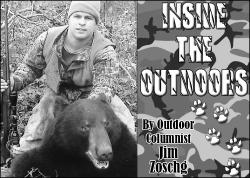Hemlock Invader hits Close to Home
3 min readThe weekend before deer season, as my father and I crossed the farm where my great-grandfather had settled after immigrating from Europe, we came across a hemlock bough that had been broken out of a nearby tree.
My stomach churned — it was covered in small, white, cottony masses, the telltale sign of the hemlock wooly adelgid.
The Zoschg homestead lies in the First Fork Valley in Cameron County, about five miles north of Sinnemahoning. In 2008 I had found evidence of the adelgid on state forest land on the opposite side of the valley. Since then, I had suspected its presence on our property.
Hemlock wooly adelgid has been killing hemlock trees in eastern forests since its introduction in the 1950s. In 2007, Forestry Bureau personnel discovered the insect in Wykoff Run in southern Cameron County. Since then populations have been discovered in Grove Run and Brooks Run, extending up the valley of the First Fork of the Sinnemahoning Creek into Sinnemahoning State Park and adjacent areas in Potter and Cameron counties.
Egg sacs of these insects look like small pieces of cotton attached to hemlock branches. The adelgid pierces and sucks fluid from the base of hemlock needles, causing them to die and fall off trees.
Although some trees die within a few years of infestation, most live on in a weakened state for many years before finally succumbing.
After hatching in May, adelgid larvae begin searching for feeding sites. Wind, birds and mammals often spread the adelgid.
Once the larvae find feeding sites at the base of healthy hemlock needles, the mobile crawler nymphs transform into immobile nymphs that feed on the hemlock, eventually developing into the adult hemlock wooly adelgid. Adelgids will produce two generations of insects a year.
Hemlocks that are being preyed upon often have an unhealthy thin, grayish appearance. During certain times of the year they also wear their namesake cottony secretions on their branches and needles.
I fear the implications for the wildlife habitat on our property.
In the winter during periods of heavy snow, these hemlock stands are utilized heavily by deer for thermal cover. The snow-covered boughs and thick foliage block wind and form a roof that helps trap heat during the cold winter nights.
Nearby, Lick Island Run enters the First Fork. The stream is covered by a heavy canopy of hemlocks that keep its water icy-cold, even on the hottest of summer days. When the adelgid has run its course, this stream and its brook trout inhabitants will surely suffer. Stream temperatures will climb. That could mean extra stress and even death to some brook trout.
There still may be a ray of hope. In 2009, the U.S. Forest Service, working with DCNR, released a cold-hardy strain of the LN beetle (Laricobius nigrinus) from the Pacific Northwest to help control adelgid populations in Sinnemahoning State Park.
LN beetles feed solely on the wooly adelgid when released in eastern forests. It is hoped that as the wooly adelgid populations continue to spread, the LN beetle will spread with them. Only time will tell.
Read this story and more in this week’s edition of the Endeavor News. Available at your favorite local retailers.

